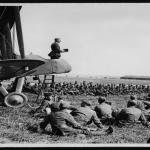We have heard so much recently about the end of the First World War in November 1918, but there is another anniversary around this time that was even more significant for its role in reshaping Christianity, and in laying the foundations for the religious world we know today. I am referring to the influenza epidemic that swept the world at that time. The raw numbers alone are incredible.
To a world already thoroughly smitten with war, death, and famine there came an apocalyptic plague of unimaginable scale. In 1918, as the final battles of the war began, there appeared a virulent new strain of influenza that swept the world. Its biblical quality was neatly captured in Katherine Anne Porter’s classic tale of the disease as it struck Denver. Her story bore the suitably Revelation-themed title Pale Horse, Pale Rider.
The pandemic struck in two distinct waves. The first appeared in the United States in March 1918, when millions of troops were billeted together in close quarters that proved an ideal incubator for the new illness. Transatlantic troopships proved particularly effective for this purpose. By June, the sickness had reached India and Australia. In the first phase, the old and weak were especially likely to perish, but a second and still more lethal form of influenza arrived in August, and this claimed the young and strong. Mortality was at its highest in the closing months of 1918.
When we recall the US experience in the Great War, we usually cite a figure of 110,000 military dead. Actually, that is very misleading, as it includes 45,000 who died due to influenza – 30,000 before they even reached France.
Raw statistics only hint at the scale of destruction. At the time, Western observers focused on the devastation in their own countries—600,000 dead in the United States, 400,000 in France, 250,000 in Britain—but the global consequences were far larger. In all, the Great War itself killed perhaps ten million in four years. In just one year, from mid-1918 through mid-1919, the Spanish flu pandemic killed at least fifty million, and some estimates put the death toll at twice that. And this occurred at a time when global population was around 1.8 billion, little over a quarter of what it is today. If the estimate of a hundred million is correct, that would account for almost ten percent of the world’s young adults at that time. A third of the world’s population was affected to some degree.
If the death toll actually was a hundred million, that would be equivalent to eliminating the entire population of the United States at that time.
To put the disaster in context, the most notorious epidemic of our own time is AIDS, which claimed some 25 million lives between 1981 and 2011. The influenza epidemic killed far more in four months than did AIDS in thirty years, and it had a much greater impact on the social fabric.
The epidemic hit savagely in what we today call the Global South. India alone might have lost twenty million people, or five percent of its total population, and in particular areas the death count reached twenty percent. Making matters still worse, the next two years were marked by widespread crop failures and famine. Over a million perished in the Dutch East Indies.
The African story is particularly significant, as it gave a historic boost to native Christian leaders and prophets, and to healing churches. As I noted, the second and much deadlier phase of the flu epidemic appeared in multiple sites in August of 1918, initially in ports used for transporting military personnel and supplies. One was the British base at Freetown in Sierra Leone, which meant that the virus now had a foothold in West Africa. Those same ports and trading towns that had done such an impressive job in disseminating new religious ideas were now the transmission points for the lethal influenza. Faith and flu followed the same well-trodden routes. Influenza was soon raging across the continent, from Nigeria in the west to Ethiopia and Somalia in the east. Four or perhaps five million Africans perished.
Disastrously for the prestige of the colonial empires, even the most advanced European medicine and science could make little headway against the disease: Africans died like Europeans or Americans. Administrators were alarmed to find ordinary Africans actually blaming whites for spreading the disease, and rejecting their medicines – reasonably enough, as the quinine and aspirin freely handed out by white doctors were useless in the circumstances. Coming at a time when Africans were deeply unhappy about the demands of war, the influenza disaster boosted nationalist and anti-imperial sentiment, and discredited theories of white supremacy.
As so often in European history, many believers felt that they had received special prophetic gifts and God’s power was poured forth regardless of familiar restrictions of race, class, or political power. One such prophet, in South Africa’s Eastern Cape, was a middle-aged Xhosa woman, Nontetha Nkwenkwe. While suffering from influenza, she had a dream revelation in which Jesus told her of the dreadful ills besetting the earth, those sins that had provoked God to visit the world with the deadly sickness. On recovery, Nontetha began her prophetic mission to insist that everyone follow strict puritanical rules. Her millenarian followers, the true Israelites, gathered at a holy village to await the apocalypse. Her dream ended in disaster when police stormed the settlement, killing hundreds, while Nontetha herself spent the remaining years of her life in a mental hospital.
But other leaders had a lasting impact. The epidemic opened the door to new religious messages, at a time when the wartime withdrawal of missions meant that Europeans lost the ability to watch over the seeds they had sown. Across the continent, independent and prophetic Christian movements boomed. This was an era of mass movements, healings, religious risings, nationalist Christian restructuring, Marian visions. And these outbreaks occurred across vast swaths of the continent, with strikingly similar manifestations thousands of miles apart, in utterly different cultural and ethnic settings.
When historians look at the growth of these new African churches, it’s easy to miss the critical significance of the war years. Some of the key movements predated 1914, while many of the most influential new churches claim later foundation dates in the mid-1920s or beyond. But a closer look at the careers of the church founders makes it clear just how decisive were the years of war and, specifically, the influenza epidemic.
One product of the upsurge of faith was the Nigerian Aladura movement, the name taken from a Yoruba word meaning “owners of prayer,” or “praying people.” The term Aladura refers to what has now become a very diverse group of independent churches— the Cherubim and Seraphim, the Church of the Lord (Aladura), the Celestial Church of Christ—all united by their belief in healing and living prophecy. All, moreover, can be traced to a wave of enthusiastic prayer and healing groups founded in 1918.
Not just in Nigeria, the crises of these years generated a prophetic response. The Gold Coast (Ghana) was hard hit by influenza, losing at least a hundred thousand dead. It was amidst this chaos that Joseph Jehu-Appiah (“Jemisemiham”) received his divine mission from an apparition of three angels, who ordained him as king. His practices of healing and speaking in tongues led to his ejection from the Methodist Church and to the foundation of a new Musama Disco Christo Church (MDCC), which continues today. Like many independent African churches, the MDCC takes the whole of the Bible very seriously, both Old and New Testaments, but Jehu-Appiah’s followers went so far as to recreate the ritual law of the ancient Hebrews. The church has a holy city with a temple, and only on one day of the year may a priest enter the holy of holies. As for the Aladura, God was speaking again as in biblical times, and his African children listened attentively.
Although these churches appeal to very different social groups and cultural traditions, some groups are already well on the way to becoming new global denominations, active in many countries. Today, they use the latest technology to spread their messages, and some churches regularly list members in dozens of countries. The most successful is the Redeemed Christian Church of God (RCCG), which seeks to evangelize North America and Europe as well as Africa. Like other independent churches, it has over time moved away from close identification with its African roots or any particular ethnicity or tribe and has become more like a dynamic Pentecostal denomination. Today, RCCG congregations are found in a dozen African nations and across much of Western Europe, and the church has a vibrant presence in North America. But this globalization represents just a new phase in the organic evolution of a movement that has never fully lost its origins in a period of trauma and catastrophe.
They are heirs of 1918.
















